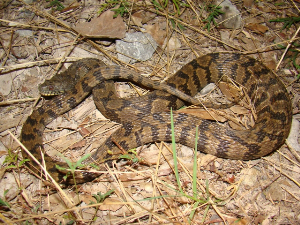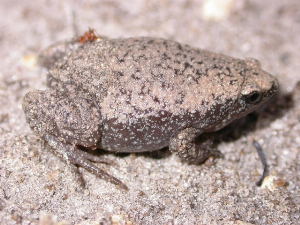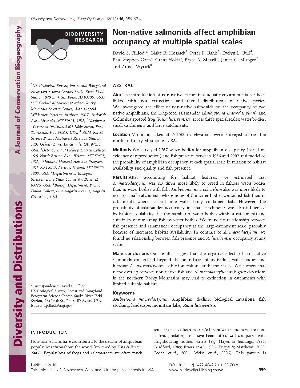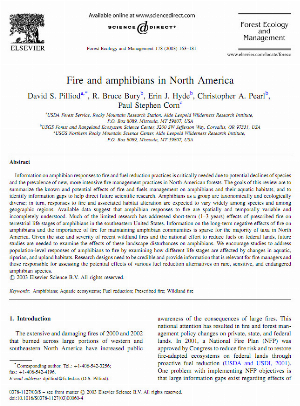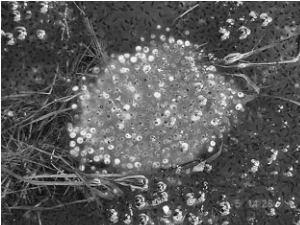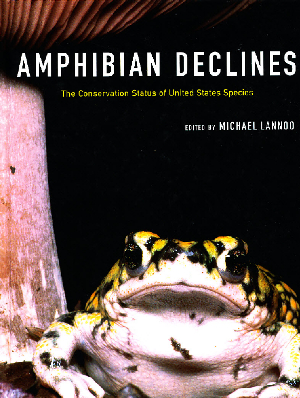Search ARMI Database
Search term(s)
Contribution Number
Search Results
879 record(s) found.
Papers & Reports Detection of wood frog egg masses and implications for amphibian monitoring programs
Authors: R D Scherer
Date: 2008 | Outlet: Copeia 2008: 669–672
Papers & Reports Occurrence of Batrachochytrium dendrobatidis in amphibian populations in Denmark
Authors: R Scalera; Michael J Adams; Stephanie K Galvan
Date: 2008 | Outlet: Herpetological Review 39: 199-200
In summer 2007, we hand captured individual amphibians in Denmark and sampled them for B. dendrobatidis. We found B. dendrobatidis on individuals from both species sampled and at 2 of the 4 study areas we examined. One of the positive results was for an adult of Rana kl. esculenta captured in Vestamager. The other positive result was for a juvenile of Rana temporaria captured in Egense.
Papers & Reports Estimating abundance from repeated presence-absence data or point counts
Authors: J A Royle; J D Nichols
Date: 2003 | Outlet: Ecology 84: 777-790
Papers & Reports Rana pretiosa (Oregon spotted frog). Aggregation and Habitat Use
Authors: C J Rombough; Christopher A Pearl
Date: 2005 | Outlet: Herpetological Review 36: 307-308
Papers & Reports Pseudacris triseriata (western chorus frog) and Rana sylvatica (wood frog) – Chytridiomycosis
Authors: S Rittmann; Erin Muths; David E Green
Date: 2003 | Outlet: Herpetological Review 34: 53
PSEUDACRIS TRISERIATA (Western Chorus Frog) and RANA SYLVATICA (Wood frog). CHYTRIDIOMYCOSIS. Chytrid fungus (Batrachochytrium dendrobatidis) is a known pathogen of anuran amphibians, and has been correlated with amphibian die-offs worldwide (Daszak et. al. 1999. Emerging Infectious Diseases 5: 735-748). In Colorado, B. dendrobatidis has infected Boreal toads (Bufo boreas)and has been identified on museum specimens of northern leopard frogs (Rana pipiens) (Carey et. al. 1999. Developmental and Comparative Immunology 23: 459-472). We report the first verified case of chytrid fungus in chorus frogs (Pseudacris triseriata) and wood frogs (Rana sylvatica) in the United States.
Papers & Reports Effects of urbanization on the distribution and abundance of amphibians and invasive species in southern California streams
Authors: Seth PD Riley; Gary T Busteed; Lee B Kats; Thomas L Vandergon; Lena FS Lee; Rosi G Dagit; Jacob L Kerby; Robert N Fisher; Raymond M Sauvajot
Date: 2005 | Outlet: Conservation Biology 19: 1894-1907
Papers & Reports A portable non-invasive trapping array for sampling amphibians and reptiles
Authors: Amanda N Rice; Kenneth G Rice; Hardin J Waddle; Frank J Mazzotti
Date: 2006 | Outlet: Herpetological Review 37: 429-430
Describes a drift fence array used in shallow marshes that does not require digging.
Papers & Reports Herpetofaunal Inventories of the National Parks of South Florida and the Caribbean: Volume III. Big Cypress National Preserve
Authors: Kenneth G Rice; Hardin J Waddle; B M Jeffery; Amanda N Rice; H F Percival
Date: 2005 | Outlet: U. S. Geological Survey, Open-File Report 2005-1300, Fort Lauderdale, FL, USA
Amphibian declines and extinctions have been documented around the world, often in protected natural areas. Concern for this trend has prompted the U.S. Geological Survey and the National Park Service to document all species of amphibians that occur within U.S. National Parks and to search for any signs that amphibians may be declining. This study, an inventory of amphibian species in Big Cypress National Preserve, was conducted from 2002 to 2003. The goals of the project were to create a georeferenced inventory of amphibian species, use new analytical techniques to estimate proportion of sites occupied by each species, look for any signs of amphibian decline (missing species, disease, die-offs, and so forth.), and to establish a protocol that could be used for future monitoring efforts.
Several sampling methods were used to accomplish these goals. Visual encounter surveys and anuran vocalization surveys were conducted in all habitats throughout the park to estimate the proportion of sites or proportion of area occupied (PAO) by each amphibian species in each habitat. Opportunistic collections, as well as limited drift fence data, were used to augment the visual encounter methods for highly aquatic or cryptic species. A total of 545 visits to 104 sites were conducted for standard sampling alone, and 2,358 individual amphibians and 374 reptiles were encountered. Data analysis was conducted in program PRESENCE to provide PAO estimates for each of the anuran species.
All of the amphibian species historically found in Big Cypress National Preserve were detected during this project. At least one individual of each of the four salamander species was captured during sampling. Each of the anuran species in the preserve was adequately sampled using standard herpetological sampling methods, and PAO estimates were produced for each species of anuran by habitat. This information serves as an indicator of habitat associations of the species and relative abundance of sites occupied, but it will also be useful as a comparative baseline for future monitoring efforts.
In addition to sampling for amphibians, all encounters with reptiles were documented. The sampling methods used for detecting amphibians are also appropriate for many reptile species. These reptile locations are included in this report, but the number of reptile observations was not sufficient to estimate PAO for reptile species. We encountered 35 of the 46 species of reptiles believed to be present in Big Cypress National Preserve during this study, and evidence exists of the presence of four other reptile species in the Preserve.
This study found no evidence of amphibian decline in Big Cypress National Preserve. Although no evidence of decline was observed, several threats to amphibians were identified. Introduced species, especially the Cuban treefrog (Osteopilus septentrionalis), are predators and competitors with several native frog species. The recreational use of off-road vehicles has the potential to affect some amphibian populations, and a study on those potential impacts is currently underway. Also, interference by humans with the natural hydrologic cycle of south Florida has the potential to alter the amphibian community.
Continued monitoring of the amphibian species in Big Cypress National Preserve is recommended. The methods used in this study were adequate to produce reliable estimates of the proportion of sites occupied by most anuran species, and are a cost-effective means of determining the status of their populations.
Several sampling methods were used to accomplish these goals. Visual encounter surveys and anuran vocalization surveys were conducted in all habitats throughout the park to estimate the proportion of sites or proportion of area occupied (PAO) by each amphibian species in each habitat. Opportunistic collections, as well as limited drift fence data, were used to augment the visual encounter methods for highly aquatic or cryptic species. A total of 545 visits to 104 sites were conducted for standard sampling alone, and 2,358 individual amphibians and 374 reptiles were encountered. Data analysis was conducted in program PRESENCE to provide PAO estimates for each of the anuran species.
All of the amphibian species historically found in Big Cypress National Preserve were detected during this project. At least one individual of each of the four salamander species was captured during sampling. Each of the anuran species in the preserve was adequately sampled using standard herpetological sampling methods, and PAO estimates were produced for each species of anuran by habitat. This information serves as an indicator of habitat associations of the species and relative abundance of sites occupied, but it will also be useful as a comparative baseline for future monitoring efforts.
In addition to sampling for amphibians, all encounters with reptiles were documented. The sampling methods used for detecting amphibians are also appropriate for many reptile species. These reptile locations are included in this report, but the number of reptile observations was not sufficient to estimate PAO for reptile species. We encountered 35 of the 46 species of reptiles believed to be present in Big Cypress National Preserve during this study, and evidence exists of the presence of four other reptile species in the Preserve.
This study found no evidence of amphibian decline in Big Cypress National Preserve. Although no evidence of decline was observed, several threats to amphibians were identified. Introduced species, especially the Cuban treefrog (Osteopilus septentrionalis), are predators and competitors with several native frog species. The recreational use of off-road vehicles has the potential to affect some amphibian populations, and a study on those potential impacts is currently underway. Also, interference by humans with the natural hydrologic cycle of south Florida has the potential to alter the amphibian community.
Continued monitoring of the amphibian species in Big Cypress National Preserve is recommended. The methods used in this study were adequate to produce reliable estimates of the proportion of sites occupied by most anuran species, and are a cost-effective means of determining the status of their populations.
Papers & Reports Herpetofaunal Inventories of the National Parks of South Florida and the Caribbean: Volume I. Everglades National Park
Authors: Kenneth G Rice; Hardin J Waddle; M E Crockett; B M Jeffery; H F Percival
Date: 2004 | Outlet: U.S. Geological Survey, Open-File Report 2004-1065, Fort Lauderdale, FL, USA
Amphibian declines and extinctions have been documented around the world, often in protected natural areas. Concern for this alarming trend has prompted the U.S. Geological Survey and the National Park Service to document all species of amphibians that occur within U.S. National Parks and to search for any signs that amphibians may be declining. This study, an inventory of amphibian species in Everglades National Park, was conducted during 2000 to 2003. The goals of the project were to create a georeferenced inventory of amphibian species, use new analytical techniques to estimate proportion of sites occupied by each species, look for any signs of amphibian decline (missing species, disease, die-offs, etc.), and to establish a protocol that could be used for future monitoring efforts.
Several sampling methods were used to accomplish all of these goals. Visual encounter surveys and anuran vocalization surveys were conducted in all habitats throughout the park to estimate the proportion of sites or proportion of area occupied (PAO) by each amphibian species in each habitat. Opportunistic collections, as well as some drift fence and aquatic funnel trap data were used to augment the visual encounter methods for highly aquatic or cryptic species. A total of 562 visits to 118 sites were conducted for standard sampling alone, and 1788 individual amphibians and 413 reptiles were encountered. Data analysis was done in program PRESENCE to provide PAO estimates for each of the anuran species.
All but one of the amphibian species thought to occur in Everglades National Park was detected during this project. That species, the Everglades dwarf siren (Pseudobranchus axanthus belli), is especially cryptic and probably geographically limited in its range in Everglades National Park. The other three species of salamanders and all of the anurans in the park were sampled adequately using standard herpetological sampling methods. PAO estimates were produced for each species of anuran by habitat. This information is valuable now as an indicator of habitat associations of the species and relative abundance of sites occupied, but it will also be useful as a comparative baseline for future monitoring efforts.
In addition to sampling for amphibians, all encounters with reptiles were documented. The sampling methods used for detecting amphibians are also appropriate for many reptile species. These reptile locations are included in this report, but there were not enough locations for most reptile species to analyze the PAO of individual species. 37 of the 57 species of reptiles thought to occur in Everglades National Park were detected during this study.
This study found no evidence of amphibian decline in Everglades National Park. There was one species not detected, but there is no evidence to indicate it has been extirpated from the park. Although no declines were observed, several threats to amphibians were identified. Introduced species, especially the Cuban treefrog (Osteopilus septentrionalis), are predators and competitors with several native frog species. Also, interference by humans with the natural hydrological cycle of the Everglades has the potential to alter the amphibian community. Finally, habitat loss outside the park has the potential to leave the amphibians in Everglades National Park isolated from other populations.
Continued monitoring of the amphibian species in Everglades National Park is recommended. The methods used in this study are adequate to produce reliable estimates of the proportion of sites occupied by most anuran species. Continuing this protocol is a cost-effective way of determining whether species are decreasing or increasing in abundance of sites occupied.
Several sampling methods were used to accomplish all of these goals. Visual encounter surveys and anuran vocalization surveys were conducted in all habitats throughout the park to estimate the proportion of sites or proportion of area occupied (PAO) by each amphibian species in each habitat. Opportunistic collections, as well as some drift fence and aquatic funnel trap data were used to augment the visual encounter methods for highly aquatic or cryptic species. A total of 562 visits to 118 sites were conducted for standard sampling alone, and 1788 individual amphibians and 413 reptiles were encountered. Data analysis was done in program PRESENCE to provide PAO estimates for each of the anuran species.
All but one of the amphibian species thought to occur in Everglades National Park was detected during this project. That species, the Everglades dwarf siren (Pseudobranchus axanthus belli), is especially cryptic and probably geographically limited in its range in Everglades National Park. The other three species of salamanders and all of the anurans in the park were sampled adequately using standard herpetological sampling methods. PAO estimates were produced for each species of anuran by habitat. This information is valuable now as an indicator of habitat associations of the species and relative abundance of sites occupied, but it will also be useful as a comparative baseline for future monitoring efforts.
In addition to sampling for amphibians, all encounters with reptiles were documented. The sampling methods used for detecting amphibians are also appropriate for many reptile species. These reptile locations are included in this report, but there were not enough locations for most reptile species to analyze the PAO of individual species. 37 of the 57 species of reptiles thought to occur in Everglades National Park were detected during this study.
This study found no evidence of amphibian decline in Everglades National Park. There was one species not detected, but there is no evidence to indicate it has been extirpated from the park. Although no declines were observed, several threats to amphibians were identified. Introduced species, especially the Cuban treefrog (Osteopilus septentrionalis), are predators and competitors with several native frog species. Also, interference by humans with the natural hydrological cycle of the Everglades has the potential to alter the amphibian community. Finally, habitat loss outside the park has the potential to leave the amphibians in Everglades National Park isolated from other populations.
Continued monitoring of the amphibian species in Everglades National Park is recommended. The methods used in this study are adequate to produce reliable estimates of the proportion of sites occupied by most anuran species. Continuing this protocol is a cost-effective way of determining whether species are decreasing or increasing in abundance of sites occupied.
Papers & Reports Herpetofaunal Inventories of the National Parks of South Florida and the Caribbean: Volume II. Virgin Islands National Park
Authors: Kenneth G Rice; Hardin J Waddle; M E Crockett; R R Carthy; H F Percival
Date: 2005 | Outlet: U.S. Geological Survey, Open-File Report 2005-1301, Fort Lauderdale, FL, USA
Amphibian declines and extinctions have been documented around the world, often in protected natural areas. Concern for this alarming trend has focused attention on the need to document all species of amphibians that occur within U.S. National Parks and to search for any signs that amphibians may be declining. This study, an inventory of amphibian species in Virgin Islands National Park, was conducted from 2001 to 2003. The goals of the project were to create a georeferenced inventory of amphibian species, use new analytical techniques to estimate proportion of sites occupied by each species, look for any signs of amphibian decline (missing species, disease, die-offs, etc.), and to establish a protocol that could be used for future monitoring efforts.
Several sampling methods were used to accomplish these goals. Visual encounter surveys and anuran vocalization surveys were conducted in all habitats throughout the park to estimate the proportion of sites or proportion of area occupied (PAO) by amphibian species in each habitat. Line transect methods were used to estimate density of some amphibian species and double observer analysis was used to refine counts based on detection probabilities. Opportunistic collections were used to augment the visual encounter methods for rare species. Data were collected during four sampling periods and every major trail system throughout the park was surveyed.
All of the amphibian species believed to occur on St. John were detected during these surveys. One species not previously reported, the Cuban treefrog (Osteopilus septentrionalis), was also added to the species list. That species and two others (Eleutherodactylus coqui and Eleutherodactylus lentus) bring the total number of introduced amphibians on St. John to three. We detected most of the reptile species thought to occur on St. John, but our methods were less suitable for reptiles compared to amphibians.
No amphibian species appear to be in decline at this time. We found no evidence of disease or of malformations. Our surveys provide a snapshot picture of the status of the amphibian species, so continued monitoring would be necessary to determine long-term trends, but several potential threats to amphibians were identified. Invasive species, especially the Cuban treefrog, have the potential to decrease populations of native amphibians. Introduced mammalian predators are also a potential threat, especially to the reptiles of St. John, and mammalian grazers might have indirect effects on amphibians and reptiles through habitat modification. Finally, loss of habitat to development outside the park boundary could harm some important populations of amphibians and reptiles on the island.
Several sampling methods were used to accomplish these goals. Visual encounter surveys and anuran vocalization surveys were conducted in all habitats throughout the park to estimate the proportion of sites or proportion of area occupied (PAO) by amphibian species in each habitat. Line transect methods were used to estimate density of some amphibian species and double observer analysis was used to refine counts based on detection probabilities. Opportunistic collections were used to augment the visual encounter methods for rare species. Data were collected during four sampling periods and every major trail system throughout the park was surveyed.
All of the amphibian species believed to occur on St. John were detected during these surveys. One species not previously reported, the Cuban treefrog (Osteopilus septentrionalis), was also added to the species list. That species and two others (Eleutherodactylus coqui and Eleutherodactylus lentus) bring the total number of introduced amphibians on St. John to three. We detected most of the reptile species thought to occur on St. John, but our methods were less suitable for reptiles compared to amphibians.
No amphibian species appear to be in decline at this time. We found no evidence of disease or of malformations. Our surveys provide a snapshot picture of the status of the amphibian species, so continued monitoring would be necessary to determine long-term trends, but several potential threats to amphibians were identified. Invasive species, especially the Cuban treefrog, have the potential to decrease populations of native amphibians. Introduced mammalian predators are also a potential threat, especially to the reptiles of St. John, and mammalian grazers might have indirect effects on amphibians and reptiles through habitat modification. Finally, loss of habitat to development outside the park boundary could harm some important populations of amphibians and reptiles on the island.
Papers & Reports Herpetofaunal Inventories of the National Parks of south Florida and the Caribbean: Volume IV. Biscayne National Park
Authors: Kenneth G Rice; Hardin J Waddle; M E Crockett; Christopher D Bugbee; B M Jeffery; H F Percival
Date: 2007 | Outlet: U. S. Geological Survey, Open-File Report 2007-1057, Fort Lauderdale, FL, USA
Amphibian declines and extinctions have been documented around the world, often in protected natural areas. Concern for this alarming trend has prompted the U.S. Geological Survey and the National Park Service to document all species of amphibians that occur within U.S. National Parks and to search for any signs that amphibians may be declining. This study, an inventory of amphibian species in Biscayne National Park, was conducted during 2002 and 2003. The goals of the project were to create a georeferenced inventory of amphibian species, use new analytical techniques to estimate proportion of sites occupied by each species, look for evidence of known stressors or problems that may lead to amphibian population decline (invasive species, disease, die-offs, and so forth), and to establish a baseline and methodology that could be used for future monitoring efforts.
Four sampling methods were used to accomplish these goals. Visual encounter surveys and anuran vocalization surveys were conducted at a total of 236 visits to 37 sites in all habitats throughout Biscayne National Park to estimate the proportion of sites or proportion of area occupied (PAO) by each amphibian species in each habitat. More than 100 individuals of 7 amphibian species were detected during standard sampling, and 24 individuals of 6 species of amphibians and 37 individuals of 12 species of reptiles were encountered during opportunistic collections and nighttime road surveys used to augment the visual encounter methods for more rare or cryptic species opportunistically. The software PRESENCE was used to provide PAO estimates for each of the anuran species based on the visual encounter surveys and anuran vocalization data.
Amphibian species (six native and three non-native) were documented in Biscayne National Park during this project. The proportion of area occupied estimates obtained for the six most common amphibians will serve as a comparative baseline for future monitoring efforts. There were fourteen non-marine reptile species detected during this study. The proportion of area occupied for reptile species was not estimated because there were too few encounters during this study. The methods used in this study are adequate to produce reliable estimates of the proportion of sites occupied by most anuran species. Therefore, future sampling at regular intervals could be a cost-effective way of following amphibian occupancy trends.
This study identified some threats to amphibians in Biscayne National Park, especially introduced species including the Cuban treefrog (Osteopilus septentrionalis), the marine or cane toad (Bufo marinus), and the greenhouse frog (Eleutherodactylus planirostris planirostris) that were collectively detected nearly three times as often as native species.
Four sampling methods were used to accomplish these goals. Visual encounter surveys and anuran vocalization surveys were conducted at a total of 236 visits to 37 sites in all habitats throughout Biscayne National Park to estimate the proportion of sites or proportion of area occupied (PAO) by each amphibian species in each habitat. More than 100 individuals of 7 amphibian species were detected during standard sampling, and 24 individuals of 6 species of amphibians and 37 individuals of 12 species of reptiles were encountered during opportunistic collections and nighttime road surveys used to augment the visual encounter methods for more rare or cryptic species opportunistically. The software PRESENCE was used to provide PAO estimates for each of the anuran species based on the visual encounter surveys and anuran vocalization data.
Amphibian species (six native and three non-native) were documented in Biscayne National Park during this project. The proportion of area occupied estimates obtained for the six most common amphibians will serve as a comparative baseline for future monitoring efforts. There were fourteen non-marine reptile species detected during this study. The proportion of area occupied for reptile species was not estimated because there were too few encounters during this study. The methods used in this study are adequate to produce reliable estimates of the proportion of sites occupied by most anuran species. Therefore, future sampling at regular intervals could be a cost-effective way of following amphibian occupancy trends.
This study identified some threats to amphibians in Biscayne National Park, especially introduced species including the Cuban treefrog (Osteopilus septentrionalis), the marine or cane toad (Bufo marinus), and the greenhouse frog (Eleutherodactylus planirostris planirostris) that were collectively detected nearly three times as often as native species.
Papers & Reports Water-quality and amphibian population data for Maryland, Washington, D.C., and Virginia, 2001-2004
Authors: Karen C Rice; R E Jung
Date: 2004 | Outlet: U.S. Geological Survey Open-File Report 2004-1401: 45
Data on the chemical composition of water and on amphibian populations were collected at least annually from vernal pool and stream sites in Maryland, Washington, D.C., and Virginia from 2001 through 2004.
Papers & Reports Water-quality data at amphibian research sites in Maryland, Washington, D.C., and Virginia, 2005-2007
Authors: Karen C Rice
Date: 2007 | Outlet: U.S. Geological Survey Open-File Report 2008-1204: 12
Data on the chemical composition of water were collected at least once from 47 amphibian research sites in Maryland, Washington, D.C., and Virginia, from 2005 through 2007.
Papers & Reports Three decades of urbanization: estimating the impact of land-cover change on stream salamander populations
Authors: S J Price; M E Dorcas; A L Gallant; R W Klaver; J D Willson
Date: 2006 | Outlet: Biological Conservation 133: 436-441
Papers & Reports Effects of the amphibian chytrid fungus on toad survival
Authors: David S Pilliod; Erin Muths; R D Scherer; Paul E Bartelt; P. Stephen Corn; Blake R Hossack; Brad A Lambert; Rebecca M McCaffery; C Gaughan
Date: 2010 | Outlet: Conservation Biology 24: 1259-1268
Chytridiomycosis is an amphibian disease linked with population declines worldwide, yet there is little information about its effects on the demography of infected populations. We used capture-recapture data from two infected populations and one uninfected population of boreal toads (Bufo boreas) in the Rocky Mountains, U.S.A. to examine a priori hypotheses about the effect of the amphibian chytrid fungus (Batrachochytrium dendrobatidis, Bd) on survival probability (Φ) and population growth rate (). Bd-positive toads had lower average annual Φ than Bd-negative individuals at sites where Bd was detected suggesting that chytridiomycosis may reduce survival by 31-42% in wild boreal toads. Bd-negative toads at infected sites had comparable survival probabilities as Bd-negative toads at the uninfected site, further supporting observed differences. Model results indicated weak evidence that environmental covariates (particularly cold temperatures during the breeding season) influenced toad survival. The diseased populations were declining by 5 - 7% per year over the 6 years of this study whereas the Bd-free population had comparatively stable ( ≈ 1) population growth. Our data suggest that Bd is a low-level chronic mortality factor in these toad populations rather than an acute factor causing rapid population declines. These results show how some amphibian populations may be coexisting with the amphibian chytrid fungus and highlight the importance of quantitative assessments of survival in wildlife populations challenged with disease.
Papers & Reports Non-native salmonids affect amphibian occupancy at multiple spatial scales
Authors: David S Pilliod; Blake R Hossack; Peter F Bahls; Evelyn L Bull; P. Stephen Corn; G Hokit; B A Maxell; J C Munger; P Murphy; A Wyrick
Date: 2010 | Outlet: Diversity and Distributions 16: 959–974
Aim
The introduction of non-native species into aquatic environments has been linked with local extinctions and altered distributions of native species. We investigated the effect of non-native salmonids on the occupancy of two native amphibians, the long-toed salamander (Ambystoma macrodactylum) and Columbia spotted frog (Rana luteiventris), across three spatial scales: water bodies, small catchments and large catchments.
Location
Mountain lakes at >1500 m elevation were surveyed across the northern Rocky Mountains, USA.
Methods
We surveyed 2267 water bodies for amphibian occupancy (based on evidence of reproduction) and fish presence between 1986 and 2002 and modelled the probability of amphibian occupancy at each spatial scale in relation to habitat availability and quality and fish presence.
Results
After accounting for habitat features, we estimated that A. macrodactylum was 2.3 times more likely to breed in fishless water bodies than in water bodies with fish. Ambystoma macrodactylum also was more likely to occupy small catchments where none of the water bodies contained fish than in catchments where at least one water body contained fish. However, the probability of salamander occupancy in small catchments was also influenced by habitat availability (i.e. the number of water bodies within a catchment) and suitability of remaining fishless water bodies. We found no relationship between fish presence and salamander occupancy at the large-catchment scale, probably because of increased habitat availability. In contrast to A. macrodactylum, we found no relationship between fish presence and R. luteiventris occupancy at any scale.
Main conclusions
Our results suggest that the negative effects of non-native salmonids can extend beyond the boundaries of individual water bodies and increase A. macrodactylum extinction risk at landscape scales. We suspect that niche overlap between non-native fish and A. macrodactylum at higher elevations in the northern Rocky Mountains may lead to extinction in catchments with limited suitable habitat.
The introduction of non-native species into aquatic environments has been linked with local extinctions and altered distributions of native species. We investigated the effect of non-native salmonids on the occupancy of two native amphibians, the long-toed salamander (Ambystoma macrodactylum) and Columbia spotted frog (Rana luteiventris), across three spatial scales: water bodies, small catchments and large catchments.
Location
Mountain lakes at >1500 m elevation were surveyed across the northern Rocky Mountains, USA.
Methods
We surveyed 2267 water bodies for amphibian occupancy (based on evidence of reproduction) and fish presence between 1986 and 2002 and modelled the probability of amphibian occupancy at each spatial scale in relation to habitat availability and quality and fish presence.
Results
After accounting for habitat features, we estimated that A. macrodactylum was 2.3 times more likely to breed in fishless water bodies than in water bodies with fish. Ambystoma macrodactylum also was more likely to occupy small catchments where none of the water bodies contained fish than in catchments where at least one water body contained fish. However, the probability of salamander occupancy in small catchments was also influenced by habitat availability (i.e. the number of water bodies within a catchment) and suitability of remaining fishless water bodies. We found no relationship between fish presence and salamander occupancy at the large-catchment scale, probably because of increased habitat availability. In contrast to A. macrodactylum, we found no relationship between fish presence and R. luteiventris occupancy at any scale.
Main conclusions
Our results suggest that the negative effects of non-native salmonids can extend beyond the boundaries of individual water bodies and increase A. macrodactylum extinction risk at landscape scales. We suspect that niche overlap between non-native fish and A. macrodactylum at higher elevations in the northern Rocky Mountains may lead to extinction in catchments with limited suitable habitat.
Papers & Reports Fire and amphibians in North America
Authors: David S Pilliod; Richard B Bury; E J Hyde; Christopher A Pearl; P. Stephen Corn
Date: 2003 | Outlet: Forest Ecology and Management 178: 163–181
Information on amphibian responses to fire and fuel reduction practices is critically needed due to potential declines of species and the prevalence of new, more intensive fire management practices in North American forests. The goals of this review are to summarize the known and potential effects of fire and fuels management on amphibians and their aquatic habitats, and to identify information gaps to help direct future scientific research. Amphibians as a group are taxonomically and ecologically diverse; in turn, responses to fire and associated habitat alteration are expected to vary widely among species and among geographic regions. Available data suggest that amphibian responses to fire are spatially and temporally variable and incompletely understood. Much of the limited research has addressed short-term (1–3 years) effects of prescribed fire on terrestrial life stages of amphibians in the southeastern United States. Information on the long-term negative effects of fire on amphibians and the importance of fire for maintaining amphibian communities is sparse for the majority of taxa in North America. Given the size and severity of recent wildland fires and the national effort to reduce fuels on federal lands, future studies are needed to examine the effects of these landscape disturbances on amphibians. We encourage studies to address population-level responses of amphibians to fire by examining how different life stages are affected by changes in aquatic, riparian, and upland habitats. Research designs need to be credible and provide information that is relevant for fire managers and those responsible for assessing the potential effects of various fuel reduction alternatives on rare, sensitive, and endangered amphibian species.
Papers & Reports Saprolegniaceae identified on amphibian eggs throughout the Pacific Northwest, USA, by internal transcribed spacer sequences and phylogenetic analysis
Authors: J E Petrisko; Christopher A Pearl; David S Pilliod; P P Sheridan; C F Williams; Charles R Peterson; Richard B Bury
Date: 2008 | Outlet: Mycologia 100: 171-180
We assessed the diversity and phylogeny of Saprolegniaceae on amphibian eggs from the Pacific Northwest, with particular focus on Saprolegnia ferax, a species implicated in high egg mortality. We identified isolates from eggs of six amphibians with the internal transcribed spacer (ITS) and 5.8S gene regions and BLAST of the GenBank database. We identified 68 sequences as Saprolegniaceae and 43 sequences as true fungi from at least nine genera. Our phylogenetic analysis of the Saprolegniaceae included isolates within the genera Saprolegnia, Achlya and Leptolegnia. Our phylogeny grouped S. semihypogyna with Achlya rather than with the Saprolegnia reference sequences. We found only one isolate that grouped closely with S. ferax, and this came from a hatchery-raised salmon (Idaho) that we sampled opportunistically. We had representatives of 7–12 species and three genera of Saprolegniaceae on our amphibian eggs. Further work on the ecological roles of different species of Saprolegniaceae is needed to clarify their potential importance in amphibian egg mortality and potential links to population declines.
Papers & Reports Geographical information systems and survey designs
Authors: Charles R Peterson; Stephen R Burton; Debra A Patla
Date: 2005 | Outlet: Lannoo M, editor. Amphibian declines: the conservation status of United States species. Berkeley: University of California Press 320–325
A GIS facilitates the organization and visualization of data, and can give biologists a better understanding of their landscapes, as well as identify data gaps. The objective of this paper was to introduce how to use a GIS to design and undertake amphibian surveys. Using Yellowstone National Park as an example, we used GIS to select sampling areas using randomized techniques, and to select watersheds within these areas. Within these watersheds, we then used GIS to visualize potential amphibian pond breeding habitats for field sampling. Results from this sampling effort were then organized as a GIS layer depicting the distribution and abundance of amphibian breeding populations. The GIS layer created from these data has become the baseline for comparisons with future surveys.
Papers & Reports Interspecific amplexus between western North American ranid frogs and the introduced American Bullfrog (Rana catesbeiana): An hypothesis concerning breeding interference
Authors: Christopher A Pearl; Marc P Hayes; R Haycock; J D Engler; Jay Bowerman
Date: 2005 | Outlet: American Midland Naturalist 154: 126–134

